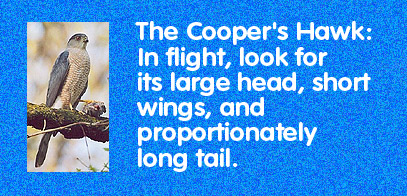This season's articles (Excerpted from our printed newsletter):
The Cooper's Hawk
The Cooper's Hawk was named in 1828 after American zoologist William Cooper, who collected the necessary specimens that were used to describe the species.  This hawk's body has a length of 14 to 21 inches and a wingspan from 27 to 36 inches. Their eyes are yellow to deep red, facing forward for good depth perception. The hooked bill is well-adapted to tearing the flesh of its favorite prey, the powerful feet and talons are long and needle-sharp. The sexes are similar in plumage; the female is larger. Their long tails act as rudders that allow them to be extremely maneuverable in wooded areas as they hunt birds on the wing. They also eat small mammals, hunting their prey by patrolling forest edges and clearings or from a perch.
This hawk's body has a length of 14 to 21 inches and a wingspan from 27 to 36 inches. Their eyes are yellow to deep red, facing forward for good depth perception. The hooked bill is well-adapted to tearing the flesh of its favorite prey, the powerful feet and talons are long and needle-sharp. The sexes are similar in plumage; the female is larger. Their long tails act as rudders that allow them to be extremely maneuverable in wooded areas as they hunt birds on the wing. They also eat small mammals, hunting their prey by patrolling forest edges and clearings or from a perch.
When prey is seen, the hawk pursues the prey with a great burst of speed, dashing through vegetation to catch their meal, which is a rather dangerous lifestyle. A recent study found that 23% of all Cooper's Hawks examined had healed fractures in the bones of the chest. This hawk captures its dinner with its feet and will squeeze it repeatedly to kill it. It does not bite the prey to kill it in the fashion of falcons, but holds it away from its body until it dies. It has been known to drown its prey, holding a bird under water until it stops moving. This may seem gruesome, but it is part of the cycle of nature.
The Cooper's Hawk can eat an amount of food equivalent to 12% of the bird's body weight in one day. This is similar to a 120-pound person eating over 14 pounds of food per day.
The male hawk, sometimes assisted by the female, builds a platform nest of sticks and twigs, occasionally rimmed with green vegetation, 20-60 feet above ground level in a tree located in a wooded area. They often place it on top of old crow, squirrel or other hawk nests.
Feeder Frenzy: Fruit and Jelly Feeders
One may not think of a special feeder for fruit and jelly but these feeders are great for supplementing the diet needs of birds. You are probably familiar to the fact that birds will raid a strawberry field or raspberry crop or peck at apples or cherries on the tree. They love fruit. Fruit feeders have a place to prop and hold apple or orange halves. Combine these feeders with dishes and now you have a fruit and jelly feeder. We also have feeders with just dishes for offering jelly, mealworms or insects to the birds. Orioles are thought to be the main species to use these feeders for they love oranges and grape jelly. Be sure to put your oranges and jelly out by the end of April to catch the orioles while they migrate to their summer homes. Other fruits enjoyed by various birds are apples, grapes, cherries, berries of all kinds, cranberries, raisins and other dried fruit. These feeders are available in a wide variety of styles and made from a choice of materials; metal, copper, plastic, wood, recycled milk jugs and combinations of materials.
Back to current newsletter













